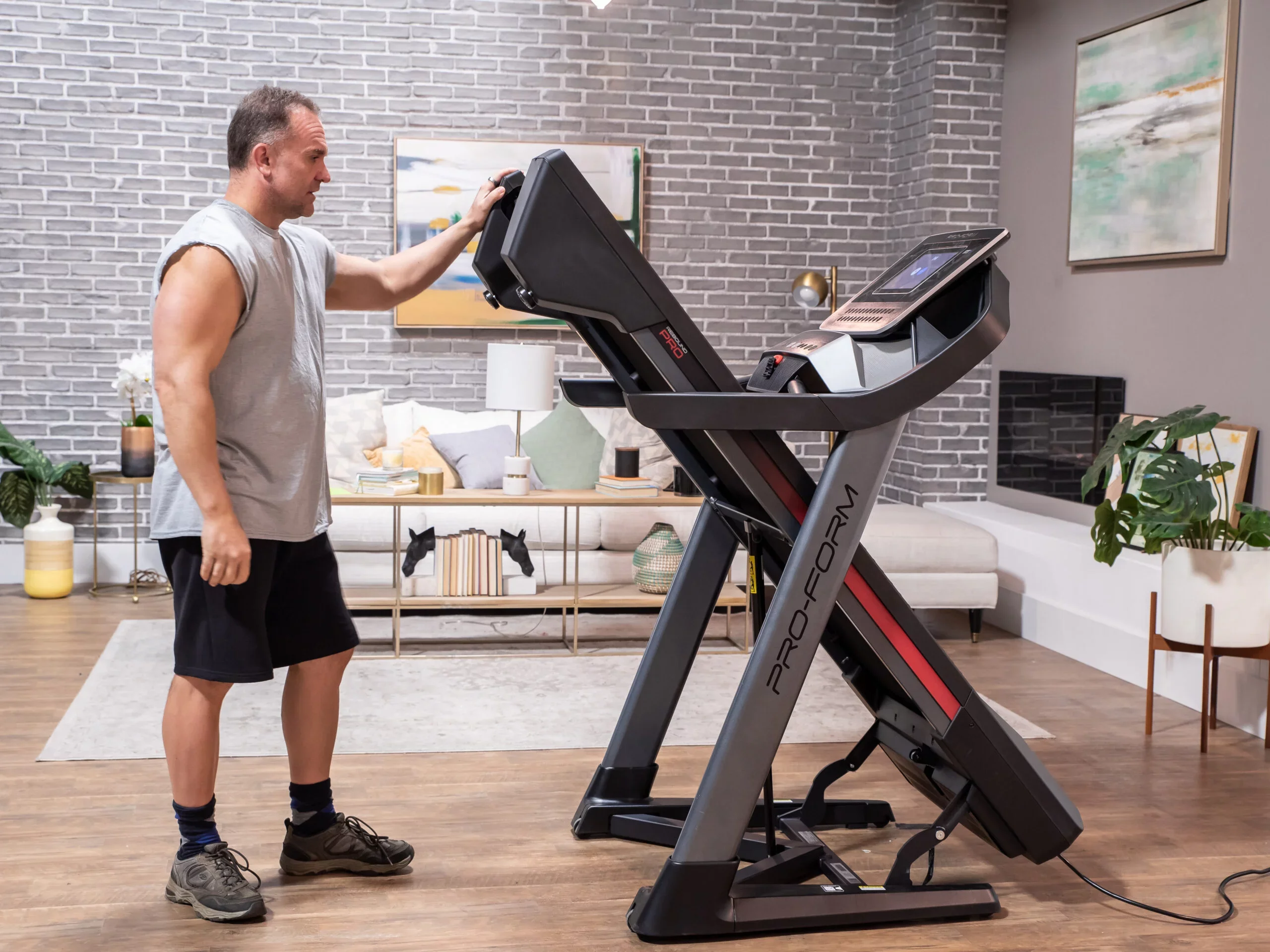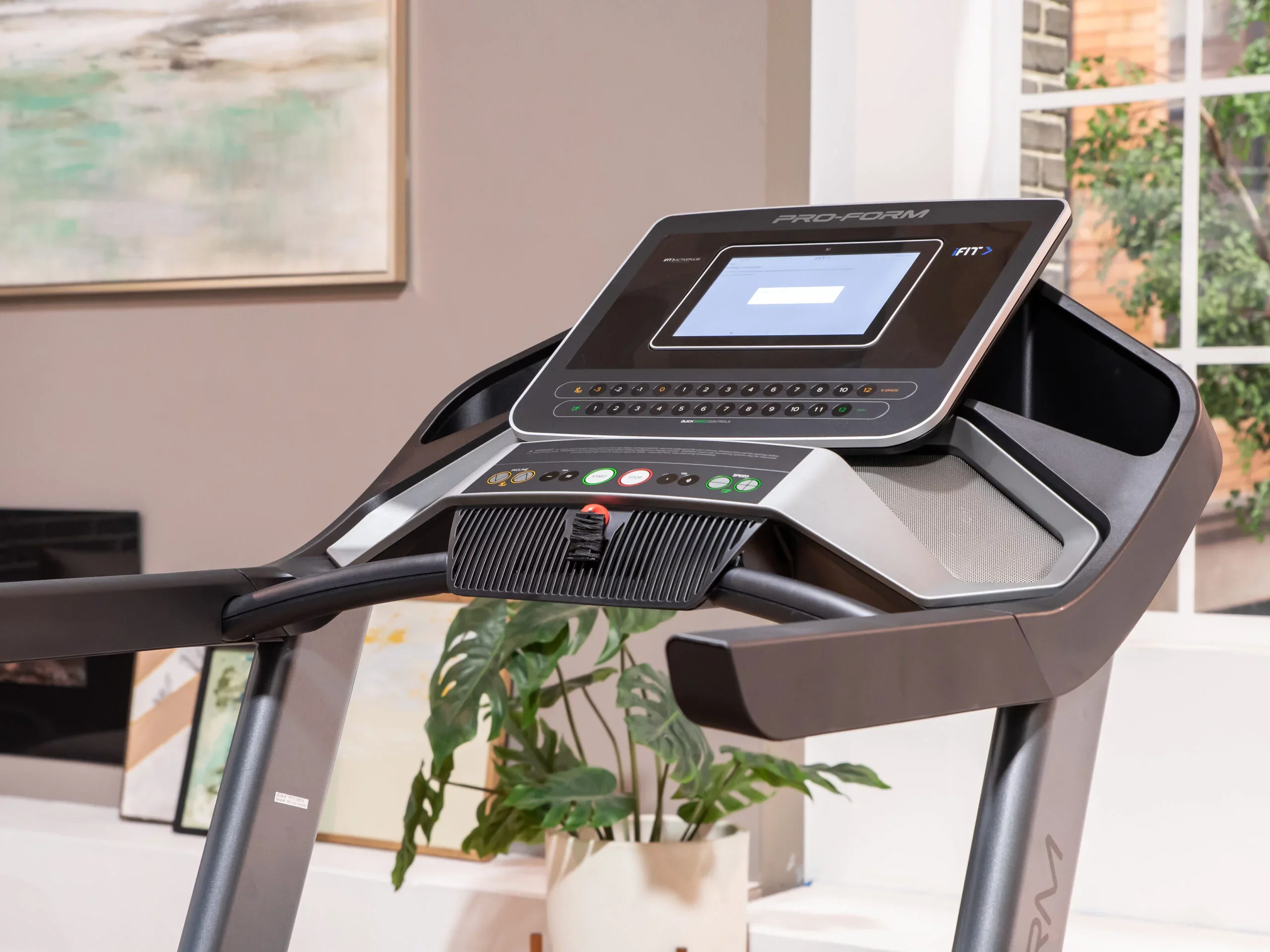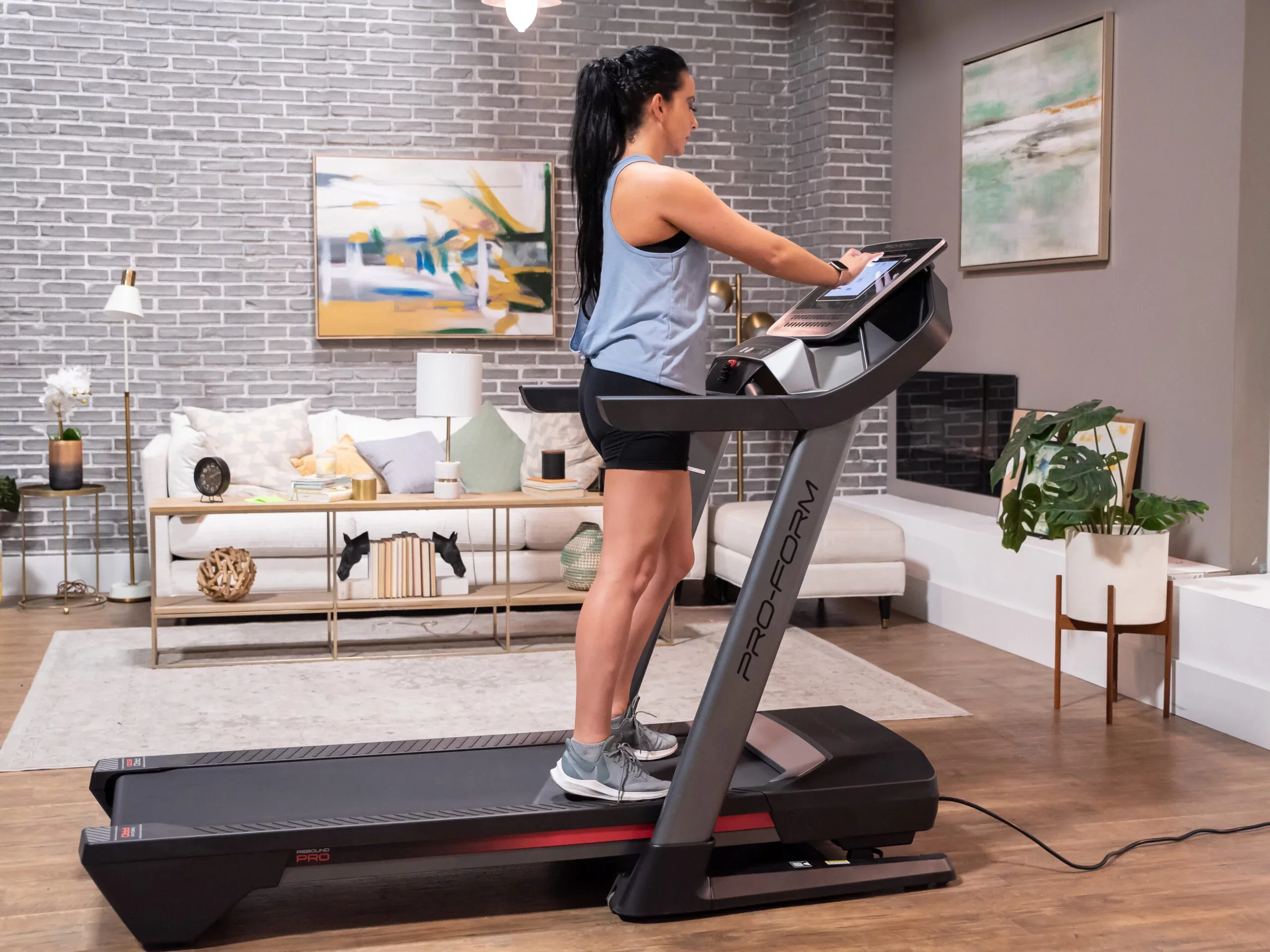My Comparison of the ProForm Pro 2000 and Sole F65
In my experience, any match-up between ProForm and Sole treadmills is going to be tough as they’re both great brands with a very different approach to workout programming. With the ProForm Pro 2000 and Sole F65, we have two treadmills priced nearly the same, with the ProForm model at $1,499 and the Sole model at $1,449.99. Aside from some of the mechanical differences I’ll outline below, the real consideration with which you’ll be faced here is what type of workout programming you want in your treadmill. ProForm treadmills, like those manufactured by NordicTrack and Freemotion, come with high-definition touchscreens equipped to work with the iFit workout app and bring automatic trainer control and ActivePulse technology for heart rate training. Meanwhile, the Sole treadmills sport an excellent media rack atop an LCD screen, a variety of built-in workouts, as well as compatibility with the cost-free Sole+ workout app. The iFit app costs $39 per month for the family plan, and about $15 per month. The ProForm Pro 2000 will work without it in a manual mode, but there are no built-in programs. Much like the interactive Peloton workout app for bikes, the iFit app has grown into an incredibly dynamic community, and for some people, it’s worth the cost.
On the whole, I’ve come to see the ProForm family of treadmills as having placed their investment in the workout programming associated with iFit, automatic trainer control, and Bluetooth heart rate control, whereas Sole tends to put its money in the machinery itself. You can see this clearly in the superior warranty they offer. All in all, if you’re looking for a great $1,500-range treadmill, you’ve come to the right place.
Feature Comparison between the ProForm Pro 2000 and the Sole F65
Here’s the specs side by side for each treadmill:
| Feature | ProForm Pro 2000 | Sole F65 |
|---|---|---|
| Motor | 3.25 CHP | 3.0 CHP |
| Running Surface | 20″ x 60″ | 22″ x 60″ |
| Incline Range | -3% -12% | 0% to 15% |
| Speed Range | 0.5 – 12 mph | 0.5 – 12 mph |
| Display | 10″ HD Touchscreen | 9″ LCD Screen |
| Weight Capacity | 300 lbs | 325 lbs |
| Built-In Programs | iFIT | 7 |
| Folding Mechanism | SpaceSaver Design EasyLift Assist Folding | Release Lever |
| Cushioning System | ReBound Pro | Yes |
| Bluetooth Connectivity | Yes | Yes |
| Dimensions | 77.3″ L x 35.3″ W x 59.6″ H | 82.5″ L x 38″ W x 67″ H |
| Warranty | 10-year frame, 2 year parts, 1 year labor | Lifetime frame and motor, 2 years deck, parts, wear items, 1 year labor |
| Best Price | Check Best Price | Check Best Price |

The ProForm Pro 2000 folds up with a simple lift. Photo by: Oleksandr Kosheliev / TreadmilReviews.net
The decision here between a ProForm Pro 2000 and Sole F65 is pretty straight-forward and comes down to preference in workout programming. The ProForm Pro 2000 is being sold online for $1,499 against the Sole F65 at $1,449.99. Meanwhile, both units can be found on special throughout the year.
The ProForm Pro 2000 is a slightly smaller and yet more dynamic machine in some respects. A folding treadmill, it measures 77.3″ x 35.3″ x 59.6″ when fully assembled and weighs 262 pounds in-box, with a 300-pound user weight maximum. In my experience, the maximum user weight is a good indicator of overall stability, and the 300- to 400-pound range is a quality grouping. ProForm offers a 10-year warranty on the frame with two years for parts and one year for labor. The running deck is 20″ x 60″ which is within the industry standard and suitable for longer strides when running, and the unit is powered by a 3.25 CHP motor. The motor pulls the belt by way of 1.9″ precision balanced rollers, and as I’ve outlined in Treadmill Decks and Belts, the rollers are those steel cylinders at either end of the deck which pull the belt. As a rule, the home treadmill market has roller sizes ranging from 1.5″ to 3″ and as a rule, the bigger the better for smooth operation and motor longevity. Heavier rollers will better keep the belt in alignment and prevent stress from the motor. You’ll also see in my piece here on treadmill motors that 3.25 CHP is plenty powerful enough for jogging and running throughout the week.
One unique plug here for the ProForm Pro 2000 is it offers both incline and decline, with a range of -3% to 12%, as well as top speeds of 12mph. The primary selling point going for the ProForm Pro 2000 is it’s not Bluetooth-enabling not only works the speakers, headphones, and heart rate monitors, but it’s iFit-enabled. With iFit-enabled equipment, whether bikes or rowers, the machine can control the workout from start to finish. I openly confess to being an iFit fan and have used it extensively. With this program you can access live, trainer-led workouts, or access any of more than 10,000 on-demand programs as ranging from cardio to weightlifting, meditation, nutrition, or use it with any of the other ProForm or NordicTrack machines. No doubt, it’s the smartest program on the market and yes you can download it onto any device and carry all of your personalized workout programming with you. If you’re looking to branch out and pick up an iFit-enabled bike or elliptical this same program will carry over by way of your profile. Unfortunately, the 10″ high-definition touchscreen only works with iFit, so no, you can’t watch Netflix on it. If you opt out of $39 per month iFit program at some point, you can always use the machine in its manual mode, but you lose access to the automatic trainer control functions.

The Sole F65 is a folding treadmill that fits easily inside your home. Photo by Sole
With the Sole F65, you’re getting a slightly larger treadmill. Measuring 82.5″ x 38″ x 67″ when fully assembled, it folds up to 42.5″ x 38″ x 72″ and has a step-up height of 8″. The unit itself weighs 267 pounds and can sport up to 325 pounds in user weight. Where Sole really shines is in the lifetime warranty offered on the frame and motor, two years for the deck, parts, wear items, and one year for labor. The 3.0 CHP motor pulls along 2.36″ rollers, which helps explain the great warranty. For the average user, a 3.0 CHP motor will be more than sufficient for jogging and running throughout the week. This treadmill also has a 22″ x 60″ running deck, slightly wider than the average model and providing more space in which to run.
The Sole F65 offers 15 levels of incline with speeds up to 12mph. In terms of programming, the treadmill comes with seven built-in workouts and a 9″ backlit LCD screen on which you can read your stats. The console displays speed, incline, time, distance, calories, pulse, pace, and has a 1/4-mile track feature with a Peak and Valley graph. It also has a terrific media rack above that screen which can hold tablets, phones, or other screens for use. You also get a USB device charging station, Bluetooth speakers, and compatibility with the cost-free Sole+ app which means data transfer to your own device. The Sole+ app is one of the best cost-free apps on the market with more than 3,000 on-demand programs for multiple styles of workouts. It’s also designed to work with other Sole branded equipment like bikes and rowers. Workouts are designed for users of all levels and can range from 10 to 60 minutes and include heart rate monitoring. Heart rate sensors are built into the handlebars and you can always sync with another heart rate monitor if you choose.

The ProForm Pro 2000 has an attractive console and set-up. Photo by: Oleksandr Kosheliev / TreadmilReviews.net
So what’s the difference in workout options? Pretty big if you ask me. If you’re familiar with the indoor biking craze associated with Peloton, you’ll understand why iFit is such a draw. With both live and on-demand workouts, it’s hard to imagine a more dynamic program than one which can auto-adjust your machine to keep up with the routine. The ActivePulse technology works by way of the SmartBeat armband heart rate monitor and not only monitors your pulse, but can also work in conjunct with iFit to control the incline and speed of the machine to keep you right where you’re supposed to be. In terms of video quality, I’ve not seen anything like it on an app. The graphics and photography associated with the videos are top-flight and so is their nutrition training. You’ll of course have all of your workout metrics logged and analyzed with new workout suggestions as frequently as you want them. You can communicate and compete with people all around the globe. But it requires a monthly fee.
Meanwhile, over on the Sole F65, you’ll never have to pay an additional dime and there’s no way you’ll get bored with their workouts. I’ve been using Sole treadmills for years and their built-in workouts offer your typical fare of High Intensity Interval Training (HIIT), 5K races, walking, jogging, heart rate control, and more. The Sole+ fitness app is cost-free and syncs with the treadmill for recording your stats. The only reason you would ever question the quality of the videos is if you’ve seen the paid app iFit. For the average person, the Sole+ app and built-in workouts are probably right on par.
In terms of workout performance, you do get a real match-up here. The ProForm model offers a -3% to 12% decline and incline range, whereas the Sole offers 15 levels of incline. So if you do the math you’ll see that ProForm offers 15 levels as does Sole, it’s just the difference in the positioning. When I’m doing hill climbing or mountain hiking, it’s obvious to me the value I get from both the decline and incline. There’s simply no easier way to intensify your workout than adjusting the elevation. But since they’re both effectively offering 15 levels here, I find this a real tie. Furthermore, they both offer up to 12mph in terms of speed, and both have motors capable of letting you run several times per week.
Given the specs, what are the pro’s and cons between the two treadmills?

The Sole F65 comes with an easy-to-read LCD screen for workout metrics as well as a handy media rack above. Photo by Sole
| ProForm Pro 2000 | Sole F65 |
|---|---|
| Pros: | Pros: |
| – Larger 3.25 CHP motor | – Lifetime frame and motor warranty |
| – iFit-enabled | – Built-in workouts and free app |
| – -3% to 12% decline | – Larger 2.36″ rollers |
| – Automatic trainer control | – Built-in heart rate sensors |
| Cons: | Cons: |
| – Screen loses value without iFit | – Bring your own screen |
| – Shorter warranty | – Larger unit may be an issue for some |
| – No built-in heart rate sensors | – No specified decline range |

The ProForm Pro 2000 has a user-friendly interface. “Photo by: Oleksandr Kosheliev / TreadmilReviews.net
A More Detailed Comparison
Motor and Performance
The ProForm Pro 2000 brings a 3.25 CHP motor compared to the Sole F65’s 3.0 CHP motor. As you’ll see in our piece here, Treadmill Motors: What You Need to Know, the difference between a 3.25 and 3.0 CHP motor isn’t that great in real terms. The bigger difference I see is in the lifetime warranty offered on the Sole motor.
Running Surface
The ProForm Pro 2000 brings an industry standard 20″ x 60″ running surface, 1.9″ rollers, as well as a 2-ply belt. Sole F65 sports a wider 22″ x 60″ deck, 2.36″ rollers, as well as a 2-ply belt. When the price is the same, bigger usually means better here.
Incline and Speed Range
The ProForm Pro 2000 offers an incline/decline range of -3% to 12% and speeds up to 12mph. The Sole F65 has 15 levels of incline and speeds up to 12mph. So both treadmills are offering 15 different levels, but the ProForm model will go lower below grade 0% whereas the Sole unit will go a bit higher up.
Display and Programs
The ProForm Pro 2000 offers a 10″ high-definition touchscreen, whereas the Sole F65 brings a 9″ backlit LCD screen. The difference is that a high-definition touchscreen is more like your iPad or a notebook, whereas the LCD screen is simply designed to show you your workout stats. It’s not as interactive. If you go with the ProForm model you’ll need the touchscreen to interact with the iFit program, whereas the Sole+ app can be managed via another device and the tablet-holder.
Cushioning and Folding Mechanism
Both treadmills feature effective cushioning systems designed to reduce impact on joints. The ProForm Pro 2000 offers ReBound Pro Cushioning, whereas the Sole F65 offers standardized cushioning.
Additional Features
Both treadmills come with Bluetooth connectivity heart rate, headphones, and speakers. The Sole F65 offers a USB charging port and heart rate sensors built into the handlebars. Both models have fans and workout trays.
Warranty and Dimensions
The ProForm Pro 2000 offers a 10-year warranty on the frame, with two years for parts and one year for labor. The Sole F65 offers a lifetime warranty on the frame and motor, two years for the deck and parts, and one year for labor.
Which would I recommend? They are both great treadmills!
Unless you’re a dedicated iFit fan, I’d say the Sole F65 brings more bang for the buck. It has built-in workouts and a free Sole+ app, as well as a much better warranty for the money. That said, if you’re into connected workouts then the iFit package is certainly top-of-the-line, particularly if you’re thinking of growing your home gym with other iFit-enabled equipment. In my experience with these machines, you really can’t go wrong here with either, it’s more a matter of programming preference.

